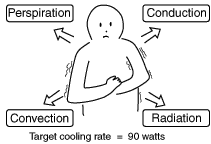Temperature Regulation of the Human Body
 |
The human body has the remarkable capacity for regulating its core temperature somewhere between 98°F and 100°F when the ambient temperature is between approximately 68°F and 130°F according to Guyton. This presumes a nude body and dry air. The external heat transfer mechanisms are radiation, conduction and convection and evaporation of perspiration. The process is far more than the passive operation of these heat transfer mechanisms, however. The body takes a very active role in temperature regulation. |
The temperature of the body is regulated by neural feedback mechanisms which operate primarily through the hypothalmus. The hypothalmus contains not only the control mechanisms, but also the key temperature sensors. Under control of these mechanisms, sweating begins almost precisely at a skin temperature of 37°C and increases rapidly as the skin temperature rises above this value. The heat production of the body under these conditions remains almost constant as the skin temperature rises. If the skin temperature drops below 37°C a variety of responses are initiated to conserve the heat in the body and to increase heat production. These include
- Vasoconstriction to decrease the flow of heat to the skin.
- Cessation of sweating.
- Shivering to increase heat production in the muscles.
- Secretion of norepinephrine, epinephrine, and thyroxine to increase heat production
- In lower animals, the erection of the hairs and fur to increase insulation.
| Modeling the cooling of the human body |
References
Guyton
Ch. 47
Benzinger
Hardy
| HyperPhysics***** Thermodynamics | R Nave |